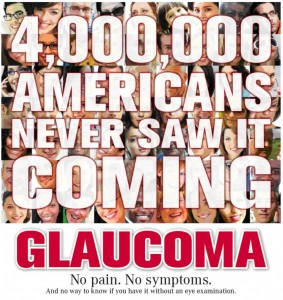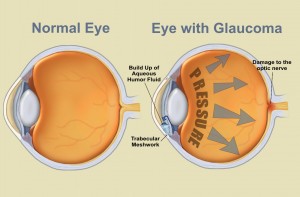January is glaucoma awareness month. Glaucoma is often called “the sneak thief of sight.”  That’s because people usually do not notice any signs of the disease until they have already lost significant vision. Once lost, vision can’t be restored. More than 2.7 million Americans age 40 and older have open angle glaucoma, the most common form of glaucoma. At least half don’t even know they have it.
That’s because people usually do not notice any signs of the disease until they have already lost significant vision. Once lost, vision can’t be restored. More than 2.7 million Americans age 40 and older have open angle glaucoma, the most common form of glaucoma. At least half don’t even know they have it.
Glaucoma is an eye disease that causes loss of sight by damaging a part of the eye called the optic nerve. This nerve sends information from your eyes to your brain. When glaucoma damages your optic nerve, you begin to lose patches of vision, usually side vision (peripheral vision). Over time, glaucoma may also damage the central vision. You may not notice a loss of side vision until you have lost a great deal of your sight. When checking for glaucoma, I measure the intra-ocular pressure, dilate the pupil to look for damage to the optic nerve and test peripheral vision. To learn more about how I identify glaucoma and how it is treated, click here
Who is at risk for glaucoma?
Below are the risk factors for glaucoma:
Age – The older you are, the greater you are at risk (especially if you are over 60 years old). African Americans are at a greater risk at a younger age starting at age 40 and older.
Race – African Americans age 40 and over are 4-5 times more likely to have glaucoma than others. Hispanics are also at increased risk for glaucoma as they age. Those of Asian and Native American descent are at increased risk for angle closure glaucoma.
Family history – If you have a parent, brother or sister with glaucoma, you are more likely to get glaucoma. If you have glaucoma, inform your family members to get complete eye exams.
Medical history – You are at risk if you have a history of high pressure in your eyes, previous eye injury, long term steroid use, or nearsightedness.
There are no symptoms for glaucoma until irreversible vision loss occurs. Have your eyes check.
